
Software predicts comfort levels

Scientists in Switzerland have come up with a computer program that calculates “how warm and cozy a person feels when wearing a piece of clothing”.
Agnes Psikuta, a researcher at the Swiss Federal Laboratories for Materials Science and Technology (Empa)External link, says it’s not so much the fabric, but rather the air between the body and the fabric that counts.
“Air gaps are responsible for more than 70% of a garment’s thermal properties,” says Psikuta. Because air is an excellent insulator, clothing insulates particularly well when there is a lot of air between the body and the outermost layer of clothing. To date, most scientific models for predicting heat loss have been based mainly on the properties of the fabric – and not on how the fabric moves.
Researchers at Empa looked for solutions to calculate the change in “air gap thickness” when people are in motion.
“We used computer programs developed for the fashion industry as a basis. These programs simulate the situation on a catwalk. Designers can create a virtual model of a garment and see how their newly designed clothes look on a person in motion,” says Psikuta. She and her team have developed software that calculates the air layers, predicts the thermal comfort of the wearer and even accounts for the influence of sweating. It can also create sewing patterns that can be tested on avatars of any size or shape.
The program helps replace countless prototypes for creating new clothing and functional gear. Empa estimates that it can cut the development period by up to 90%.
“How much time we can actually save depends greatly on the product in question and its complexity,” says Psikuta. “Protective clothing for firefighters – ultimately a health- and life-saving piece of equipment – has a very complex structure, while a sports T-shirt, on the other hand, is quite a bit easier.” In order to apply the research results in practice, Empa is cooperating with industrial partners such as winter sportsgear manufacturers.

More
Why bananas could be the fabric of the future

In compliance with the JTI standards
More: SWI swissinfo.ch certified by the Journalism Trust Initiative















![The four-metre-long painting "Sonntag der Bergbauern" [Sunday of the Mountain Farmers, 1923-24/26] had to be removed by a crane from the German Chancellery in Berlin for the exhibition in Bern.](https://www.swissinfo.ch/content/wp-content/uploads/sites/13/2025/12/01_Pressebild_KirchnerxKirchner.jpg?ver=f05a5a9c)














You can find an overview of ongoing debates with our journalists here . Please join us!
If you want to start a conversation about a topic raised in this article or want to report factual errors, email us at english@swissinfo.ch.